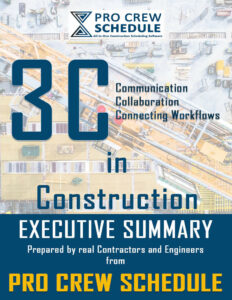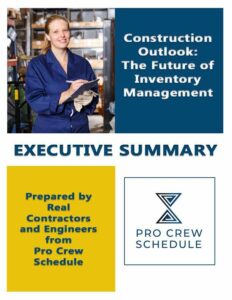Introduction
Every awe-inspiring building you see today went through a grueling construction project planning. It isn’t as simple as drawing the building, and the construction team already knows the step-by-step procedure. Without a proper plan, the operations can go astray and lead to costly errors. Hence, a well-crafted plan is necessary to achieve smooth operation and a successful outcome. In this article, we dive in deeper on how to ensure your construction project success right from pre-construction phase.
Good construction starts with a solid foundation. That’s true of the building structure itself, but also the planning that goes into any construction job. Any construction process, big or small, involves different phases. These phases were created to keep activities organized in a step-bystep manner so that none of them gets left out. They also serve as a good guide to the team so errors will be minimized. But the basis for the success of a project greatly relies on the planning phase. Here, the owner lays down the objective of the project, and from there the plan is developed. From there, design, activities, and schedules are defined.
Before anything else, let’s look into the phases of construction that construction professionals should keep an eye on.
The 6 Phases of Construction Process
For every stage of a construction project, from the simplest to the most complex, there are certain steps and processes that need to be followed to ensure a successful outcome. Projects in construction may vary based on their size, the number of stakeholders involved, budget and delivery date. Regardless of the case, though, a construction project is always a long and demanding process.
The good news is that with the continuous progress of digital solutions, the management of the different project phases can now be done much easier and with higher precision. On top of that, the collection of valuable data from the field can play a decisive role in improving, and ideally, standardizing the construction process for future projects.
In a nutshell, here are the 6 stages of a construction project and what you should know about them:
1.Conceptualization
Normally, the conception of the project starts with the client. This is where the dream begins as well as the research for the right location and the specifications/standards that should be followed.
Depending on the project, the conception stage might vary. It can take anywhere from a few days to a few months or more, depending on how imminent is the need for the completion of the project. It goes without saying that construction workers usually don’t have much input during this stage, as the ball is still in the hands of the project owner.
2.Designing
Once the project is closer to fruition, it is time to sit down and talk design. This is still a preliminary stage, which means that nothing is guaranteed at this point. Nevertheless, design is the stage where usually the bidding process begins.
The team that is in charge of the design, led by an architect or an engineer, will need to make sure that each of the state regulations and codes is met while respecting the vision of the project owner as well as ensuring that the newly built structure will be usable.
There are normally four different steps within the design stage and they include programming and feasibility, schematic design, design development, and contract documents.
3. Pre-construction
The next stage of a construction project begins when the bidding is completed and the contractor has been chosen to do the work. As soon as the contractor is chosen, the project team is put together.
Typically, a project team has the task to prepare the construction site before the work begins. As a rule, it consists of the following specialties:
- Contract administrator
- Project Manager
- Superintendent
- Field Engineer and Field Architect
- Health and Safety Manager
In close collaboration with the contractor, the project team is responsible for visiting the field in order to complete a site examination. The site examination will allow the project team to detect or predict any environmental challenges that might emerge during the building process. Soil testing is also an integral part of this step.
When all information is collected, all plans and findings should be reviewed by the city authorities. This is usually a long procedure, as all concerns and opinions should be heard and addressed.
4.Procurement
Now it’s time for the project team to order and obtain materials, equipment, and workforce. This stage of the project can be more or less complex and challenging depending on how big the project is, the available resources and the agreed start date.
Many of the big construction companies have their own procurement departments. In such cases, it is common that the construction company will simultaneously order laborers, equipment and materials for a number of projects. This process might vary a lot in smaller projects.
All this work is usually performed by the general contractor, however, there are times when subcontractors will be in charge of certain parts. The subcontractors may be responsible for hiring their own workers or obtaining their own materials so that they know that they have exactly what they need to complete their portion of the job.
5.Construction Operation
Before the construction work begins, a pre-construction meeting is done to ensure that everyone is on the same page when the construction starts. This meeting normally includes information about the following topics:
- How to access the job site;
- The quality control of the project;
- How and where to store all the materials;
- The hours that everyone will be working.
It is also important to note that the schedule of each project agent might vary depending on their role. This is especially true for subcontractors who need certain parts of the job completed before they can begin their portion. It easily becomes evident that bad planning at this point can lead to serious delays and budget overruns.
6.Post-construction
Last but certainly not least, the post-construction stage. Now that all the work on the job site has been completed, the project will soon come to a close. Nonetheless, there are still a few steps that need to be done before the keys to the building can be handed over.

The Key to Success of Every Project— Pre-construction
As you already know, preconstruction is the most important phases in construction. Without a well-written plan, the construction process will be disorganized, and the team will never achieve a successful result. Delays in the builder’s schedule, going over the budget, accidents, and poor building quality are the most likely consequences of having an unplanned construction. But in the first place, no project is given the go signal without writing a perfect plan.
That said, project managers should carefully plan construction to have a smooth operation at the site and so that the project stays within the schedule and budget. Doing so will, of course, bring about high levels of satisfaction for your client.
But it’s not that simple.
The process is indeed long, and it becomes even harder with all the challenges faced by the project manager while writing the plan. But to deliver a project efficiently and with the highest quality and safety, he should be able to recognize the challenges and deal with them. Remember that the success of a project is much dependent on the project manager’s skill, knowledge, and ability to overcome the challenges in planning so he can write a good plan that will direct the project to its great result.
Long-time construction professionals would attest that planning is at the heart of a construction project life cycle. The planning phase basically guides everyone in a construction team to where they’re going to get there.
The construction plan is drafted by the key players in a project (today mostly on Project Management (PM) software) who put all the foreseen activities in a document. Project deliverables and requirements are then defined before the schedule of all activities is plotted. The use of materials, tools, machines, and equipment is also strategized alongside the timing of activities.
7 Components of Construction Planning
Construction planning has been greatly revolutionized, thanks to technology. BIM makes it possible for project managers and stakeholders to identify future problems so they can work on coming up with remedies even before the project starts. Construction scheduling software makes it easier to record data agreed upon during the planning phase and makes data sharing more accurate and up-to-date.
Generally, the technologies mentioned above greatly improved the following components in construction planning:
- Construction Activities: these include every movement done at the site. With so many activities needed to complete a project, planning tasks can be confusing but with a construction scheduling software, listing down these tasks has become easier and more organized without missing a detail.
- Construction Crew Schedule: estimating timelines for each activity has been more accurate because of analytics and machine learning and big data.
- Project Time-Scale: the dissemination of the activities and their due dates has become faster as they can be sent by the office through the construction scheduling software, eliminating the need to print and travel to the site to post schedules on bulletin boards.
- Events at the Site: all occurrences at the site can now be reported back to project managers in real-time so that when issues arise or when a superior consent is needed, they can act on them immediately.
- Work Method: with BIM, project managers are able to analyze the best possible procedure to follow in constructing the project.
- Resources: the four M’s in construction namely men, materials, machine, and money are better managed thanks to construction project management software that makes it possible to schedule and track activities in real-time.
- Project Value: another way to measure project progress is by defining the value-to-date of the project. This can be calculated from the budget already consumed.
With these aspects improved, construction project managers are able to come up with more efficient plans that can ensure the success of their projects.
The 3 Key Factors in Formulating Project Objectives

The Three Core Objective Baseline
The general objectives of project planning are to:
- Recognize business requirement.
- Define necessary costs, schedule, list of deliverables, and delivery date.
- Establish resources needed
Project Initiation Document (PID) Questions
Check whether the project is feasible or not and what it’s going to take to get the job done. To do that, you can start by creating a Project Initiation Document (PID). This document should describe the following so you can quickly assess whether your team is really capable of taking the project or not:
- People: based on the project objective, identify the number of crew members needed to complete the job. Also include the number of subcontractors. Then look at the number of people you currently have in your team and your ability to hire new ones if there is a deficit.
- Resources: Are the necessary materials for this project available locally? If not, do you have the ability to import?
- Budget: Check the total cost of the project. Can the owner fund it? Can you work around the budget that the owner sets without suffering from any loss?
The SMART Rule

In construction planning, it is a common practice to create several alternative routes in case the team meets unexpected problems that can cause delays. So expect to make sets of your plan before you have them approved by the owner. Planning should be done with careful attention since this phase of construction is what will help project managers manage time, cost, quality, changes, risk, and other related issues. Plans also help control the crew members and suppliers to ensure that the project will be delivered on time and within the budget.
The planning phase is where the objectives are refined since these become the bases for the design and the main plan. The objectives are gathered by the owner during the initiation phase where he can be guided by consultants and his trusted construction experts. Planning the necessary steps and resources to meet those objectives then comes next.
When articulating the objectives of a construction project, it helps to follow the S.M.A.R.T. rule:
- Specific Key Milestones: Goals of the project should be specific such as key milestones and their deadlines.
- Measurable KPIs: Set a measure for success to know whether your project if it is good enough or not and whether your activities will lead you to achieve the objective or not. To help you, set some key performance indicators (KPIs) to monitor the performance of your crew. Your KPIs can include monitoring for:
- Project objectives status
- Project performance rate
- Project quality
- Attainable Objectives: Make sure that the goal you set and the activities you assign in achieving them are attainable. If not, then consider making adjustments.
- Realistic Timelines: In line with setting attainable goals and steps, you should also make sure that they are realistic and not stressful for your crew. Allot the right span of time for finishing each phase and set an allowance for fixing errors.
- Timely Completion: Finally, set realistic time frames on when your goals can be achieved. Every finished project should be re-evaluated to see whether you achieved the goals or not. If not, look into the phases where you went wrong and plan for corrective measures. When you set a clear project plan since the beginning, the reevaluation of the project shouldn’t be difficult.
Project managers are usually appointed to describe precisely the activities and resources needed. They then consult with their team leaders and subcontractors about the lead time of completion of every activity, who should do them, and the resources needed per step. Likewise, they get the lead time of arrival of materials from suppliers. All these will be specified with great detail on the project plan.
Process of Mapping Out a Construction Plan

- Plan Project Scope: with an objective as a guide, project managers should now be able to specify the in-scope requirements needed in breaking down the activities involved in each phase.
- Breakdown Work Structure: breaking down the project phases into tasks and sub-tasks.
- Develop Project Schedule: with the activities defined, the next step is to plot the schedule by assigning due dates to each task.
- Identify Needed Resources: from the set of activities needed in each phase, identify the special skills you will need as well as the tools and equipment required to carry out the tasks.
- Plan Budget: the estimate isn’t final and now that you have a clear consultation with the project owner and the activities laid out, you should now be able to come up with a more accurate budget. Include t the budgets for your subcontractors and suppliers too.
- Layout Material Procurement: apart from the cost of your materials, take into consideration too how you will transport your materials and whether you need a warehouse for them or not. These factors also add to your construction cost so be sure to include them in the plan.
- Prepare Risk Management: check for possible risks and causes of delays and draft a contingency or mitigation plan. This is why we suggested earlier to prepare other sets of the plan in case your team faces problems along the way.
- Set Quality Criteria: to know whether the project will end up meeting the construction objective, you should set quality criteria, and when to check progresses on the site.
- Strategize Communication: in construction using phones and emails is already obsolete
The trend today is using project management software where communication and collaboration are done in real-time. The ability to share files across your secured network also makes communication more efficient plus being able to open it on tabs, PCs, mobile phones, and laptops gives crew members no excuses to miss an update. This eliminates misunderstanding between the office and the site, putting them all on the same page.
Use of Construction Scheduling Software in Planning
While construction scheduling software seems to be more useful during the construction phase than the planning stage, this technology, as we just pointed out above, has been changing the way project managers write plans. Schedules and activities are more intelligently written.
Procedures are now more organized and the workflow is now smoother. All these result to better execution of the plan that minimizes issues such as confusion and workers slacking off. As early as the 1980s, construction experts have already written reports ascertaining the need for construction software that will assist project managers in writing plans and schedules. Those reports concluded that software makes it less confusing for all stakeholders to follow a plan as they are more logically written on computers.
These days, construction management software can now run on any device, including smartphones and tablets, making it more convenient for the whole team to refer to plans and share data.
There are numerous types of project management software in the market today. But none can be as effective as construction-dedicated planning software like Pro Crew Schedule. They are equipped with features specially designed for the industry so they are sure to fulfill all the needs of project managers while writing the plan.





